Effects of the European Union Agricultural and Environmental Policies in the Sustainability of Most Common Mediterranean Soils
Abstract
:1. Introduction
2. Material and Methods
2.1. Study Area and Experimental Design
2.2. Edaphic Characterization
2.3. Climatic Characterization
2.4. Soil Sampling
2.5. Analysis
2.6. Organic Carbon
2.7. pH
2.8. Electric Conductivity
2.9. “Available” Phosphorus and Potassium
2.10. Extractable Microelements (Cadmium, Chromium, Copper, Manganese, Nickel, Lead, Zinc)
2.11. Statistical Treatment of the Results
3. Results
3.1. Organic Carbon
3.2. pH
3.3. Electric Conductivity
3.4. "Available" Phosphorus and Potassium
3.5. Heavy Metals (Cd, Cr, Cu, Zn, Mn, Pd, and Al)
4. Discussion
4.1. Organic Carbon
4.2. pH
4.3. Electric Conductivity
4.4. "Available" Phosphorus and Potassium
4.5. Heavy Metals (Cd, Cr, Cu, Zn, Mn, Pd, and Al)
5. Conclusions
Acknowledgments
Author Contributions
Conflicts of Interest
References
- Zdruli, P. Land resources of the Mediterranean: Status, pressures, trends and impacts on future regional development. Land Degrad. Dev. 2014, 25, 373–384. [Google Scholar] [CrossRef]
- Plieninger, T.; Hartel, T.; Martín-López, B.; Beaufoy, G.; Bergmeier, E.; Kirby, K.; Montero, M.J.; Moreno, G.; Oteros-Rozas, E.; Uytvanck, J. Wood-pastures of Europe: Geographic coverage, social-ecological values, conservation management, and policy implications. Biol. Conserv. 2015, 190, 70–79. [Google Scholar] [CrossRef]
- Villanueva, A.J.; Gómez-Limón, J.A.; Arriaza, M.; Rodríguez-Entrena, M. The design of agri-environmental schemes: Farmers’ preferences in southern Spain. Land Use Policy 2015, 46, 142–154. [Google Scholar] [CrossRef]
- European Soil Bureau Network/European Commission. Soil Atlas of Europe; Office for Official Publications of the European Communities: Brussels, Belgium, 2005. [Google Scholar]
- Batáry, P.; Dicks, L.V.; Kleijn, D.; Sutherland, W.J. The role of agri-environment schemes in conservation and environmental management. Conserv. Biol. 2015, 29, 1006–1016. [Google Scholar] [CrossRef] [PubMed]
- Antle, J.; Lekakis, J.; Zanias, G. Agriculture, Trade and the Environment: The Impact of Liberalization on Sustainable Development; Virginia Tech Ed: Blacksburg, VA, USA, 2016. [Google Scholar]
- Comissão Europeia. Plano de Acção em Matéria de Biodiversidade Para a Agricultura; Comissão Europeia: Brussels, Belgium, 2001. [Google Scholar]
- Hodge, I.; Hauck, J.; Bonn, A. The alignment of agricultural and nature conservation policies in the European Union. Conserv. Biol. 2015, 29, 996–1005. [Google Scholar] [CrossRef] [PubMed] [Green Version]
- Hine, R.C.; Ingersent, K.A.; Rayner, A.J. The Reform of the Common Agricultural Policy; Springer: Berlin, Germany, 2016; ISBN 1349261017, 9781349261017. [Google Scholar]
- Comissão Europeia. Adapting to Climate Change in Europe—Options for EU Action; Comissão Europeia: Brussels, Belgium, 2007. [Google Scholar]
- Rounsevell, M.; Evans, S.P.; Bullock, P. Climate Change and Agricultural Soils: Impacts and Adaptation. Clim. Chang. 1999, 43, 683–709. [Google Scholar] [CrossRef]
- Schröter, D.W.; Cramer, R.; Leemans, I.C.; Prentice, M.B.; Araújo, A.W.; Arnell, A.; Bondeau, H.; Bugmann, T.; Carter, C.A.; Gracia, A.C.; et al. Ecosystem Service Supply and Vulnerability to Global Change in Europe. Science 2005, 310, 1333–1337. [Google Scholar] [CrossRef] [PubMed]
- European Union. Regulation (EU) No. 1305/2013 of the European Parliament and of the Council of 17 December 2013 on Support for Rural Development by the European Agricultural Fund for Rural Development (EAFRD) and Repealing Council Regulation (EC) No. 1698/2005. Off. J. Eur. Union 2013, 347, 487–584. [Google Scholar]
- Grinsven, H.; Erisman, J.W.; Vries, W.; Westhoek, H. Potential of extensification of European agriculture for a more sustainable food system, focusing on nitrogen. Environ. Res. Lett. 2015, 10, 2. [Google Scholar] [CrossRef]
- Merckx, T.; Pereira, H. Reshaping agri-environmental subsidies: From marginal farming to large-scale rewilding. Basic Appl. Ecol. 2015, 16, 95–103. [Google Scholar] [CrossRef]
- Miglietta, P.P.; De Leo, F.; Massari, S. Water footprint assessment of some Italian wines: A territorial perspective. Int. J. Environ. Policy Decis. Mak. 2015, 4, 320–331. [Google Scholar] [CrossRef]
- European Union. Regulation (EU) No. 1307/2013 of the European Parliament and of the Council of 17 December 2013 Establishing Rules for Direct Payments to Farmers Under Support Schemes within the Framework of the Common Agricultural Policy and Repealing Council Regulation (EC) No. 637/2008 and Council Regulation (EC) No. 73/2009. Off. J. Eur. Union 2013, 347, 608–670. [Google Scholar]
- Comissão Europeia. Orientaciones Para una Agricultura Sostenible; Comissão Europeia: Brussels, Belgium, 1999. [Google Scholar]
- Instituto Nacional de Estatistica. Censos 2011—Resultados Preliminares; Instituto Nacional de Estatistica: Lisbon, Portugal, 2011. [Google Scholar]
- Diário da Republica Portuguesa. Portaria n.° 1212/2003, DR 240 SÉRIE I-B; ICNF: Lisbon, Portugal, 2003. [Google Scholar]
- Muñoz-Rojas, M.; Jordán, A.; Zavala, L.M.; De la Rosa, D.; Abd-Elmabod, S.K.; Anaya-Romero, M. Impact of Land Use and Land Cover Changes on Organic Carbon Stocks in Mediterranean Soils (1956–2007). Land Degrad. Dev. 2015, 26, 168–179. [Google Scholar] [CrossRef]
- Rato-Nunes, J.; Cabral, F.; López-Piñeiro, A. Short-term effects on soil properties and wheat production from secondary paper sludge application on two Mediterranean agricultural soils. Bioresour. Technol. 2008, 99, 4935–4942. [Google Scholar] [CrossRef] [PubMed]
- Bou Kheir, R.; Shomar, B.; Greve, M.B.; Greve, M.H. On the quantitative relationships between environmental parameters and heavy metals pollution in Mediterranean soils using GIS regression-trees: The case study of Lebanon. J. Geochem. Explor. 2014, 147, 250–259. [Google Scholar] [CrossRef]
- Panagos, P.; Borrelli, P.; Poesen, J.; Ballabio, C.; Lugato, E.; Meusburger, K.; Montanarella, L.; Alewell, C. The new assessment of soil loss by water erosion in Europe. Environ. Sci. Policy 2015, 54, 438–447. [Google Scholar] [CrossRef]
- Parras-Alcántara, L.; Lozano-García, B.; Brevik, E.C.; Cerdá, A. Soil organic carbon stocks assessment in Mediterranean natural areas: A comparison of entire soil profiles and soil control sections. J. Environ. Manag. 2015, 155, 219–228. [Google Scholar] [CrossRef] [PubMed]
- Laudicina, V.A.; Novara, A.; Barbera, V.; Egli, M.; Badalucco, L. Long-Term Tillage and Cropping System Effects on Chemical and Biochemical Characteristics of Soil Organic Matter in a Mediterranean Semiarid Environment. Land Degrad. Dev. 2015, 26, 45–53. [Google Scholar] [CrossRef]
- Rato Nunes, J.; Ramos-Miras, J.; Lopez-Piñeiro, A.; Loures, L.; Gil, C.; Coelho, J.; Loures, A. Concentrations of Available Heavy Metals in Mediterranean Agricultural Soils and their Relation with Some Soil Selected Properties: A Case Study in Typical Mediterranean Soils. Sustainability 2014, 6, 9124–9138. [Google Scholar] [CrossRef]
- Sierra, C.A.; Trumbore, S.E.; Davidson, E.A.; Vicca, S.; Janssens, I. Sensitivity of decomposition rates of soil organic matter with respect to simultaneous changes in temperature and moisture. J. Adv. Model. Earth Syst. 2015, 7, 335–356. [Google Scholar] [CrossRef]
- Santos, J.Q. Fertilização, Fundamentos Agroambientais da Utilização dos Adubos e Corretivos; Publindústria-Produção De Comunicação Lda: Porto, Portugal, 2015; ISBN 9789897230851. [Google Scholar]
- Varennes, A. Produtividade dos Solos e Ambiente; Livraria Escolar Editora: Maputo, Mozambique, 2003; ISBN 972-592-156-9. [Google Scholar]
- Lehmann, J.; Kleber, M. The contentious nature of soil organic matter. Nature 2015, 528, 60–68. [Google Scholar] [CrossRef] [PubMed]
- Martín, J.; Álvaro-Fuentes, J.; Gonzalo, J.; Gil, C.; Ramos-Miras, J.; Grau Corbí, M.; Boluda, M. Assessment of the soil organic carbon stock in Spain. Geoderma 2016, 264, 117–125. [Google Scholar] [CrossRef]
- Mohawesh, Y.; Taimeh, A.; Ziadat, F. Effects of land use changes and soil conservation intervention on soil properties as indicators for land degradation under a Mediterranean climate. Solid Earth 2015, 6, 857–868. [Google Scholar] [CrossRef]
- Gruba, P.; Mulder, J. Tree species affect cation exchange capacity (CEC) and cation binding properties of organic matter in acid forest soils. Sci. Total Environ. 2015, 511, 655–662. [Google Scholar] [CrossRef] [PubMed]
- Panghaal, D.; Sangwan, P.; Mittal, S. Effect of Tillage and Phosphorus Fertilization of Wheat on Inorganic Soil Phosphorus Fractions under Wheat-Sorghum Cropping System. Int. J. Curr. Microbiol. Appl. Sci. 2017, 6, 283–291. [Google Scholar] [CrossRef]
- Porta, J.; Reguerín, L.; Laburu, M. Edafología para la Agricultura y el Medio Ambiente; Ediciones Mundi-Prensa: Madrid, Spain, 2003; ISBN 9788471147844. [Google Scholar]
- Costa, C.; Papatheodorou, E.M.; Monokrousos, N.; Stamou, G.P. Spatial Variability of Soil Organic C, Inorganic N and Extractable P in a Mediterranean Grazed Area. Land Degrad. Dev. 2015, 26, 103–109. [Google Scholar] [CrossRef]
- Tan, W.F.; Zhang, R.; Cao, H.; Huang, C.Q.; Yang, Q.K.; Wang, M.K.; Koopal, L.K. Soil inorganic carbon stock under different soil types and land uses on the Loess Plateau region of China. Catena 2014, 121, 22–30. [Google Scholar] [CrossRef]
- Wang, L.; Liang, T. Effects of exogenous rare earth elements on phosphorus adsorption and desorption in different types of soils. Chemosphere 2014, 103, 148–155. [Google Scholar] [CrossRef] [PubMed]
- Kelepertzis, E. Accumulation of heavy metals in agricultural soils of Mediterranean: Insights from Argolida basin, Peloponnese, Greece. Geoderma 2015, 221–222, 82–90. [Google Scholar] [CrossRef]
- Nunes, J. Los Suelos del Perímetro Regable del Caia (Portugal): Tipos, Fertilidade, e Impacto del Riego en sus Propriedades Químicas. Ph.D. Thesis, Universidad de Extremadura, Faculdad de Ciencias, Badajoz, Spain, 2003. [Google Scholar]
- Nunes, J.; López-Piñeiro, A.; Albarrán, A.; Muñoz, A.; Coelho, J. Changes in selected soil properties caused by 30 years of continuous irrigation under Mediterranean conditions. Geoderma 2007, 139, 321–328. [Google Scholar] [CrossRef]
- Food and Agriculture Organization of the United Nations. World Referende Base for Soil Rsources—International Soil Classification System for Naming Soils and Creating Legends for Soil Maps; FAO: Rome, Italy, 2015; ISBN 978-92-5-108369-7. [Google Scholar]
- Direcção Geral de Minas e Serviços Geológicos. Carta Geológica de Portugal à Escala 1:50.000; Serviços Geológicos Instituto Geográfico e Cadastral: Lisboa, Portugal, 1969. [Google Scholar]
- Instituto de Meteorologia. Atlas Climatológico de Portugal Continental—1971–2000: Temperatura do ar e Precipitação; Instituto de Meteorologia: Lisbon, Portugal, 2009. [Google Scholar]
- Essenwanger, O.M. General Climatology 1C: Classification of Climates; Elsevier Science: Amsterdam, The Netherlands, 2001. [Google Scholar]
- Nelson, D.W.; Sommers, L.E. Total C, organic C and organic metter. In Methods of Soil Analysis; Sparks, D.L., Page, A.L., Helmke, P.A., Loeppert, R.H., Soltanpour, P.N., Tabatabai, M.A., Johnston, C.T., Sumner, M.E., Eds.; Soil Science Society of America Book Series No 5, Part 3—Chemical methods; Soil Science Society of America—America Society of Agronomy Publ.: Madison, WI, USA, 1996; pp. 961–1010. [Google Scholar]
- United State Departement of Agriculture (USDA). Soil Survey Laboratory Methods Manual; Soil Survey Investigation Report NO 42, Version 3.0; USDA: Quilcene, WA, USA, 1996; p. 692.
- Buurman, P.; Lagen, B.; Velthorst, E. Manual for Soil and Water Analysis; Backhuys Publishers Leiden: Wageningen, The Netherlands, 1996. [Google Scholar]
- Rhoades, J.D. Soluble salts. In Methods of Soil Analysis, 2nd ed.; Page, A.L., Miller, R.H., Keeney, D.R., Eds.; Part 2: Chemical and Microbiological Properties; American Society of Agronomy: Madison, WI, USA, 1982; Volume 9, pp. 167–179. [Google Scholar]
- Egnér, H.; Riehm, H.; Domingo, W.R. Untersuchhungen uber die chemische boden: Analyse als grundlage fur die beurteilung der nahrstoffzustandes der boden. II. Chemique extractions, methoden zur phosphor, und kalium-bestimmung. Kungl. Lantbrukshoegsk. Ann. 1960, 26, 199–215. [Google Scholar]
- Cottenie, A.; Verlo, M.; Kjekens, L.; Camerlynch, R. Chemical Analysis of Plant and Soil; Laboratory of Analytical Agrochemistry, State University: Gent, Belgium, 1982; Volume 42, pp. 80–284. [Google Scholar]
- Snapp, S.; Grandy, S. Advanced Soil Organic Matter Management (E-3137); Michigna State University Extension Bulletin; Michigna State University: East Lansing, MI, USA, 2012. [Google Scholar]
- Reddy, P.P. Soil Organic matter. In Sustainable Intensification of Crop Production; Springer: Berlin, Germany, 2016; pp. 157–163. ISBN 978-981-10-2701-7. [Google Scholar]
- Toshiko, M.; Kento, O.; Kazuya, N.; Muhajir, U.; Ainin, N.; Nobuhiro, K.; Koichi, F. The Effects of Nitrogen Fertilizer on Soil Microbial Communities under Conventional and Conservation Agricultural Managements in a Tropical Clay-Rich Ultisol. Soil Sci. 2016, 181, 68–74. [Google Scholar] [CrossRef]
- Jayalath, N.; Mosley, L.M.; Fitzpatrick, R.W.; Marschner, P. Addition of organic matter influences pH changes in reduced and oxidised acid sulfate soils. Geoderma 2016, 262, 125–132. [Google Scholar] [CrossRef]
- Hueso-González, P.; Martínez-Murillo, J.F.; Ruiz-Sinoga, J.D. The impact of organic amendments on forest soil properties under mediterranean climatic conditions. Land Degrad. Dev. 2014, 25, 604–612. [Google Scholar] [CrossRef]
- Behera, S.K.; Shukla, A.K. Spatial Distribution of Surface Soil Acidity, Electrical Conductivity, Soil Organic Carbon Content and Exchangeable Potassium, Calcium and Magnesium in Some Cropped Acid Soils of India. Land Degrad. Dev. 2015, 26, 71–79. [Google Scholar] [CrossRef]
- Laboratório Rebelo da Silva. Manual Prático de Fertilização das Culturas; INIAV: Lisbon, Portugal, 2000. [Google Scholar]
- Serrano, J.M.; Shahidian, S.; Marques da Silva, J.R. Soil phosphorus retention in a Mediterranean pasture subjected to differential management. Eur. J. Soil Sci. 2014, 65, 562–572. [Google Scholar] [CrossRef]
- Serrano, J.M.; Marques da silva, J.R.; Shahidian, S. Spatial and temporal patterns of potassium on grazed permanent pastures—Management challenges. Agric. Ecosyst. Environ. 2014, 188, 29–39. [Google Scholar] [CrossRef]
- Esmaeili, A.; Moore, F.; Keshavarzi, B.; Jaafarzadeh, N.; Kermani, M. A geochemical survey of heavy metals in agricultural and background soils of the Isfahan industrial zone, Iran. Catena 2014, 121, 88–98. [Google Scholar] [CrossRef]
- Roca-Perez, L.; Gil, C.; Cervera, M.L.; Gonzálvez, A.; Ramos-Miras, J.; Pons, V.; Bech, J.; Boluda, R. Selenium and heavy metals content in some Mediterranean soils. J. Geochem. Explor. 2010, 107, 110–116. [Google Scholar] [CrossRef]
- Acosta, J.A.; Faz, A.; Martinez, M. Identification of heavy metal sources by multivariable analysis in a typical Mediterranean city (SE Spain). Environ. Monit. Assess. 2010, 169, 519–530. [Google Scholar] [CrossRef] [PubMed]
- Marzaioli, R.; D’Ascoli, R.; De Pascale, R.A.; Rutigliano, F.A. Soil quality in a Mediterranean area of Southern Italy as related to different land use types. Appl. Soil Ecol. 2010, 44, 205–212. [Google Scholar] [CrossRef]

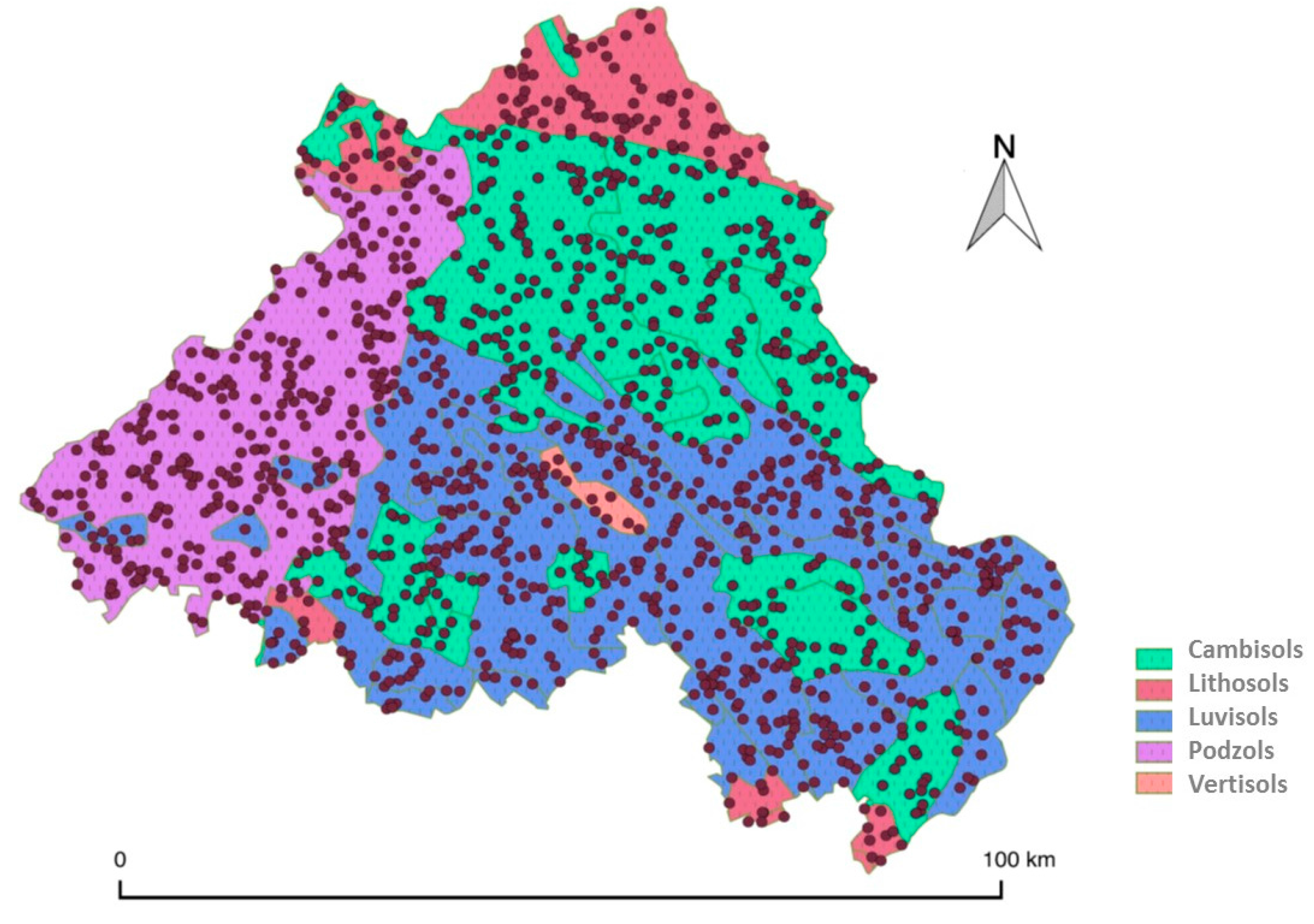
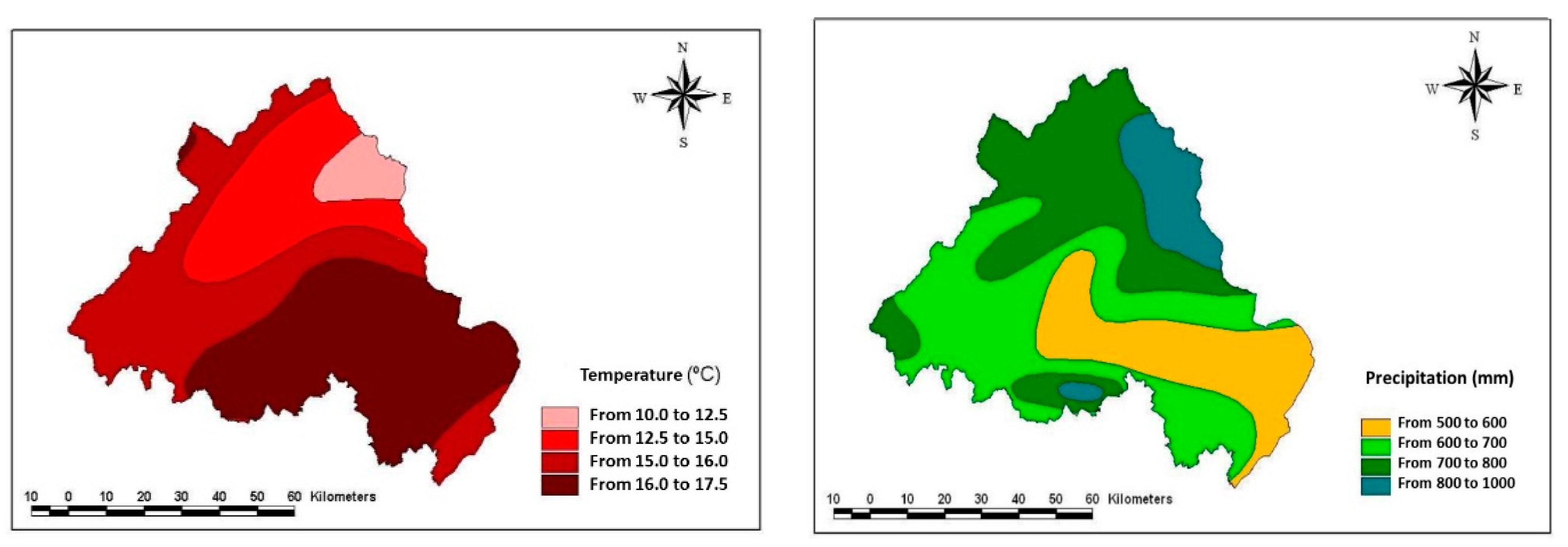


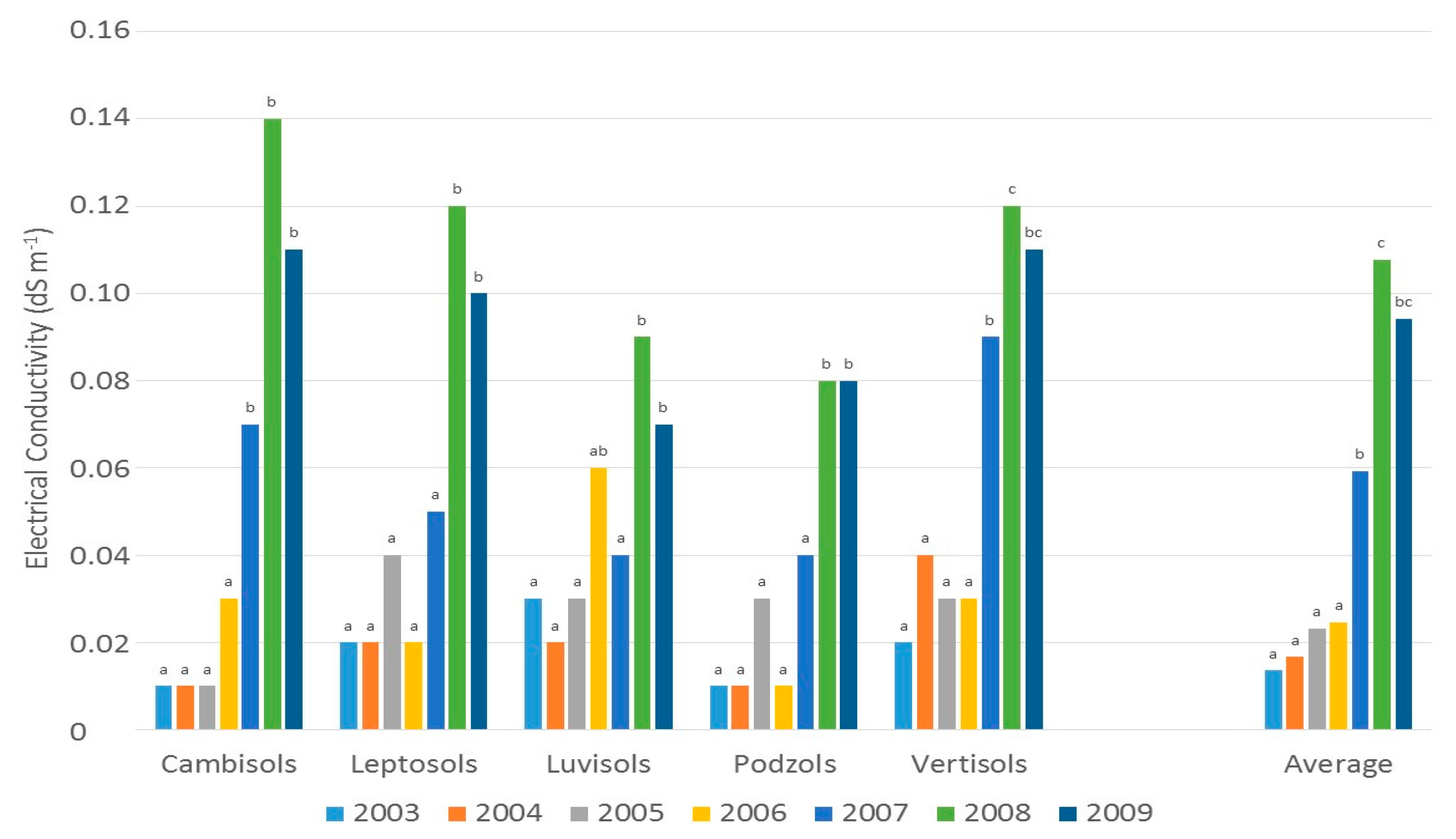
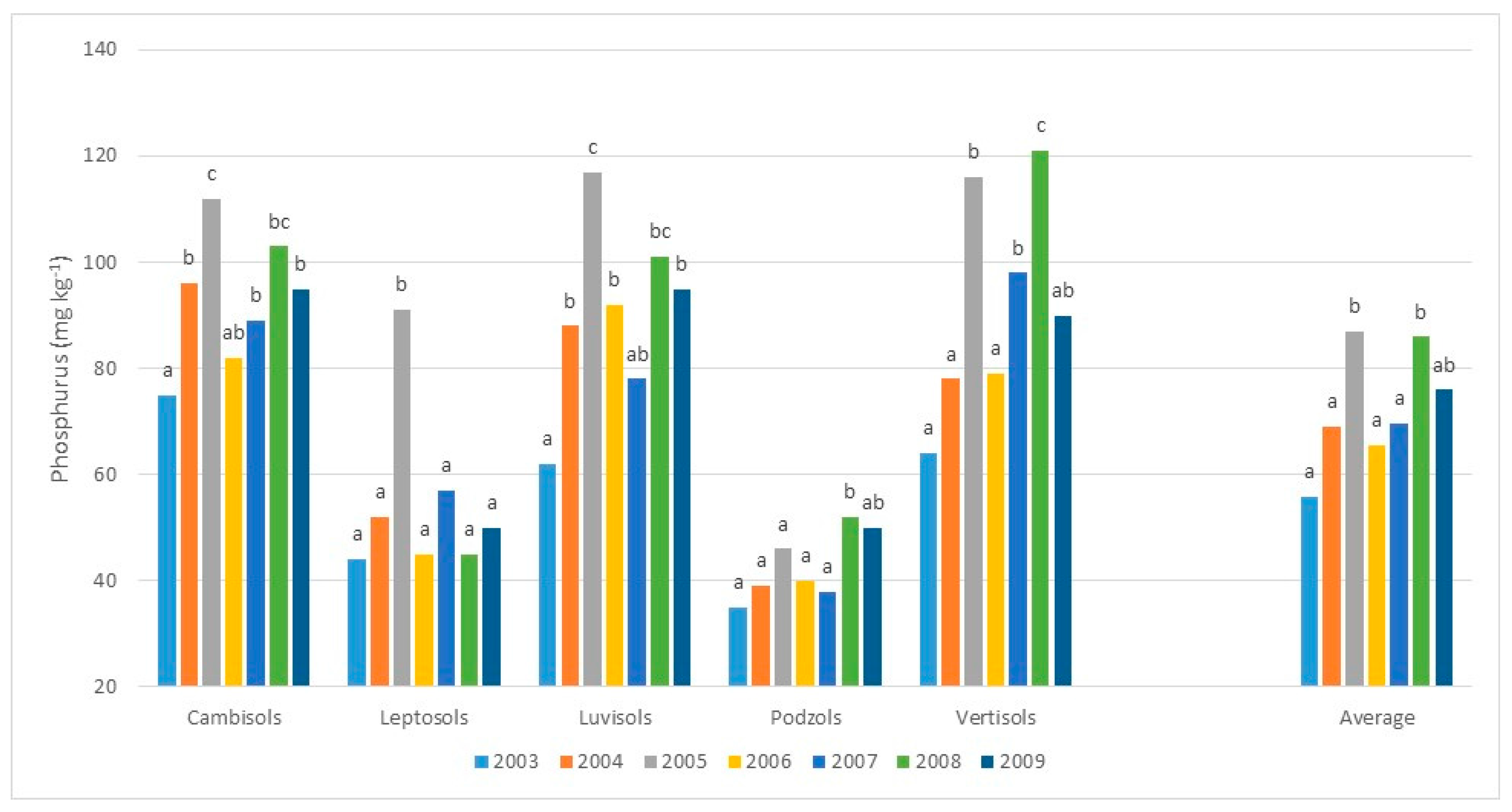
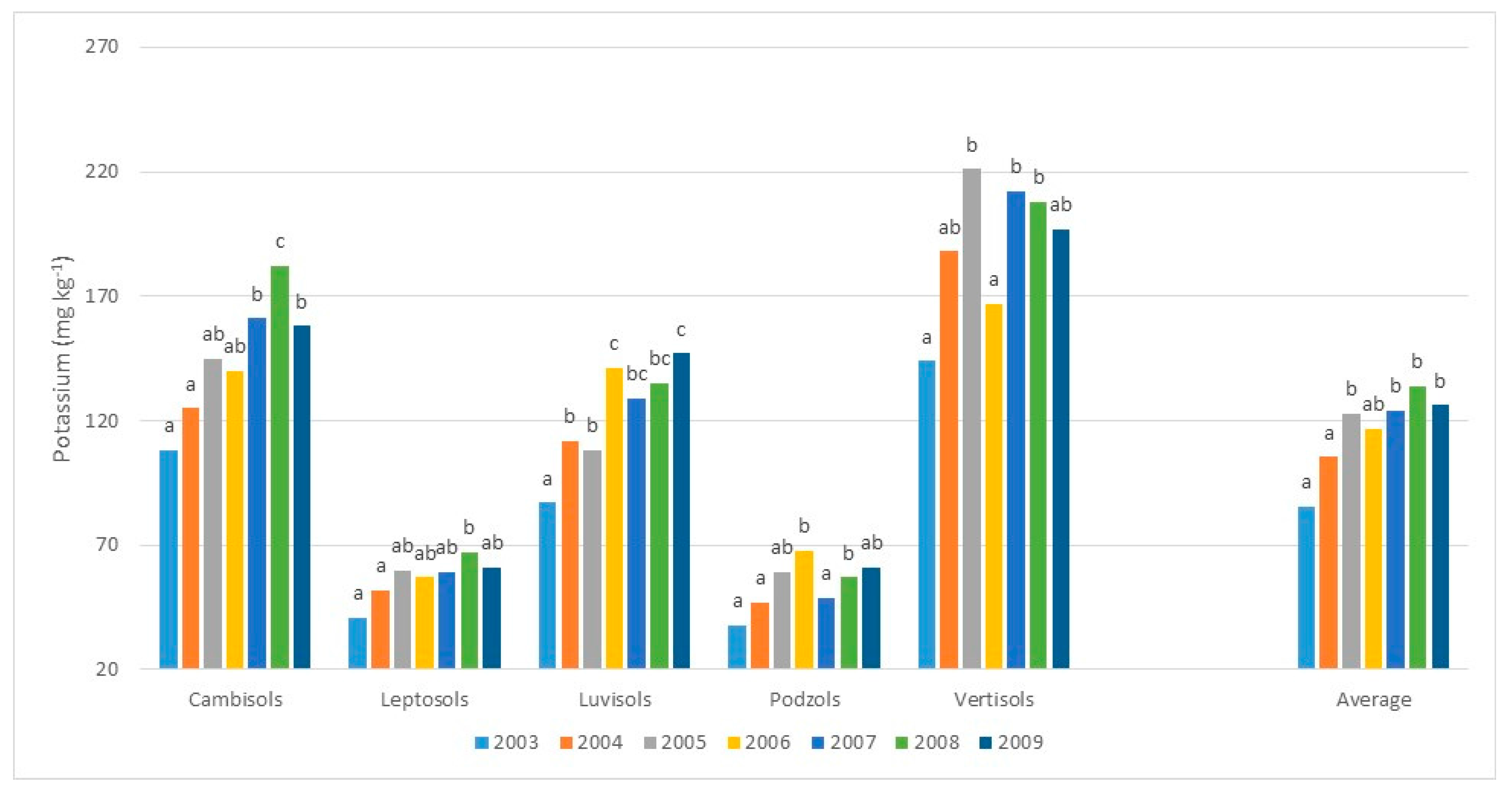
| Cambisols | Vertisols | Leptosols | Luvisols | Podzols | AVERAGE | ||
|---|---|---|---|---|---|---|---|
| Cadmium | 2003 | 0.03 a | 0.26 a | 0.11 a | 0.14 a | 0.09 a | 0.09 a |
| 2004 | 0.07 a | 0.31 a | 0.09 a | 0.22 a | 0.07 a | 0.12 a | |
| 2005 | 0.18 a | 0.37 a | 0.27 a | 0.26 a | 0.12 a | 0.20 a | |
| 2006 | 0.08 a | 0.33 a | 0.22 a | 0.17 a | 0.08 a | 0.12 a | |
| 2007 | 0.20 a | 0.30 a | 0.14 a | 0.19 a | 0.14 a | 0.17 a | |
| 2008 | 0.08 a | 0.41 a | 0.15 a | 0.23 a | 0.09 a | 0.14 a | |
| 2009 | 0.09 a | 0.32 a | 0.18 a | 0.21 a | 0.07 a | 0.13 a | |
| Chromium | 2003 | 0.32 a | 1.07 a | 0.67 a | 1.02 ab | 0.54 a | 0.76 a |
| 2004 | 0.43 a | 0.93 a | 0.98 a | 1.17 ab | 0.76 ab | 0.85 a | |
| 2005 | 1.34 b | 1.34 a | 0.99 a | 1.30 b | 1.12 b | 1.28 b | |
| 2006 | 1.10 b | 1.11 a | 1.00 a | 1.12 ab | 1.03 ab | 1.09 ab | |
| 2007 | 0.36 a | 1.24 a | 0.40 a | 0.48 a | 0.56 a | 0.58 a | |
| 2008 | 0.45 a | 0.98 a | 0.62 a | 0.61 a | 0.42 a | 0.63 a | |
| 2009 | 0.49 a | 1.15 a | 0.54 a | 0.57 a | 0.53 a | 0.65 a | |
| Copper | 2003 | 0.71 a | 1.33 a | 1.74 a | 1.45 a | 0.66 a | 1.19 a |
| 2004 | 0.84 a | 1.56 a | 1.63 a | 1.56 a | 0.69 a | 1.31 a | |
| 2005 | 0.93 a | 1.77 a | 1.87 a | 1.89 a | 0.67 a | 1.53 a | |
| 2006 | 0.65 a | 1.52 a | 1.54 a | 1.78 a | 0.48 a | 1.32 a | |
| 2007 | 0.75 a | 1.67 a | 1.34 a | 1.45 a | 0.55 a | 1.24 a | |
| 2008 | 0.73 a | 1.88 a | 1.72 a | 1.67 a | 0.68 a | 1.39 a | |
| 2009 | 0.78 a | 1.75 a | 1.83 a | 1.98 a | 0.71 a | 1.51 a | |
| Zinc | 2003 | 0.41 a | 0.36 a | 1.14 a | 0.85 a | 1.03 a | 0.75 a |
| 2004 | 0.54 a | 0.39 a | 1.03 a | 0.96 a | 1.26 a | 0.87 a | |
| 2005 | 0.63 a | 0.37 a | 1.27 a | 1.29 a | 1.47 a | 1.09 a | |
| 2006 | 0.35 a | 0.18 a | 0.94 a | 1.18 a | 1.22 a | 0.88 a | |
| 2007 | 0.45 a | 0.25 a | 0.74 a | 0.85 a | 1.37 a | 0.80 a | |
| 2008 | 0.43 a | 0.38 a | 1.12 a | 1.07 a | 1.58 a | 0.95 a | |
| 2009 | 0.48 a | 0.41 a | 1.23 a | 1.38 a | 1.45 a | 1.07 a | |
| Manganese | 2003 | 47.0 a | 22.0 a | 42.0 a | 31.0 a | 53.0 a | 41.2 a |
| 2004 | 39.0 a | 19.0 a | 37.0 a | 45.0 ab | 59.0 a | 44.7 a | |
| 2005 | 49.0 a | 31.0 ab | 35.0 a | 51.0 b | 65.0 a | 51.3 a | |
| 2006 | 41.0 a | 43.0 b | 45.0 a | 36.0 a | 41.0 a | 39.1 a | |
| 2007 | 31.0 a | 29.0 ab | 29.0 a | 33.0 a | 57.0 a | 36.5 a | |
| 2008 | 53.0 a | 27.0 a | 41.0 a | 47.0 ab | 49.0 a | 48.5 a | |
| 2009 | 55.0 a | 38.0 ab | 39.0 a | 33.0 a | 47.0 a | 43.2 a | |
| Lead | 2003 | 1.94 a | 1.11 a | 2.15 a | 1.15 a | 3.15 a | 2.67 a |
| 2004 | 2.11 a | 1.97 b | 2.89 a | 1.79 b | 3.79 a | 3.90 b | |
| 2005 | 2.78 b | 1.77 ab | 2.93 a | 1.67 b | 4.11 a | 4.11 b | |
| 2006 | 2.71 b | 2.15 b | 3.17 a | 2.25 c | 3.89 a | 4.48 b | |
| 2007 | 2.22 a | 1.63 ab | 2.77 a | 1.93 b | 2.97 a | 3.93 ab | |
| 2008 | 1.87 a | 1.65 ab | 2.07 a | 0.87 a | 2.57 a | 3.27 a | |
| 2009 | 2.83 b | 2.17 b | 2.59 a | 1.35 a | 3.99 a | 4.42 b | |
| Niquel | 2003 | 1.45 a | 3.15 a | 1.15 a | 1.55 a | 2.15 a | 1.50 a |
| 2004 | 2.35 b | 3.95 a | 1.95 b | 1.79 a | 2.30 a | 2.07 ab | |
| 2005 | 2.55 b | 3.27 a | 2.77 c | 2.15 a | 2.87 a | 2.45 b | |
| 2006 | 1.74 a | 2.96 a | 1.95 b | 1.45 a | 1.95 a | 1.67 a | |
| 2007 | 1.55 a | 2.80 a | 1.37 ab | 1.85 a | 2.25 a | 1.77 a | |
| 2008 | 1.15 a | 2.57 a | 1.18 a | 1.35 a | 1.75 a | 1.33 a | |
| 2009 | 1.40 a | 2.74 a | 1.05 a | 1.40 a | 2.45 a | 1.56 a | |
© 2017 by the authors. Licensee MDPI, Basel, Switzerland. This article is an open access article distributed under the terms and conditions of the Creative Commons Attribution (CC BY) license (http://creativecommons.org/licenses/by/4.0/).
Share and Cite
Nunes, J.M.R.; Bonito, A.; Loures, L.; Gama, J.; López-Piñeiro, A.; Peña, D.; Albarrán, Á. Effects of the European Union Agricultural and Environmental Policies in the Sustainability of Most Common Mediterranean Soils. Sustainability 2017, 9, 1404. https://doi.org/10.3390/su9081404
Nunes JMR, Bonito A, Loures L, Gama J, López-Piñeiro A, Peña D, Albarrán Á. Effects of the European Union Agricultural and Environmental Policies in the Sustainability of Most Common Mediterranean Soils. Sustainability. 2017; 9(8):1404. https://doi.org/10.3390/su9081404
Chicago/Turabian StyleNunes, José Manuel Rato, António Bonito, Luis Loures, José Gama, Antonio López-Piñeiro, David Peña, and Ángel Albarrán. 2017. "Effects of the European Union Agricultural and Environmental Policies in the Sustainability of Most Common Mediterranean Soils" Sustainability 9, no. 8: 1404. https://doi.org/10.3390/su9081404
APA StyleNunes, J. M. R., Bonito, A., Loures, L., Gama, J., López-Piñeiro, A., Peña, D., & Albarrán, Á. (2017). Effects of the European Union Agricultural and Environmental Policies in the Sustainability of Most Common Mediterranean Soils. Sustainability, 9(8), 1404. https://doi.org/10.3390/su9081404






